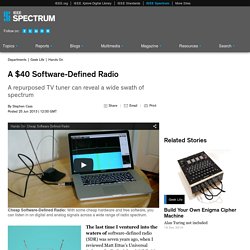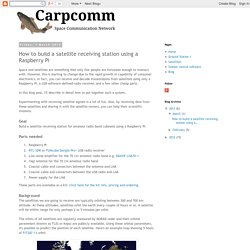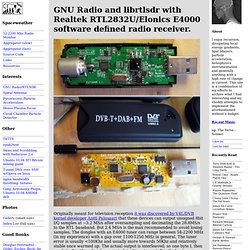

数字电视中文网. Software Defined Radio for Mariners. A $40 Software-Defined Radio. The last time I ventured into the waters of software-defined radio (SDR) was seven years ago, when I reviewed Matt Ettus’s Universal Software Radio Peripheral.

While it’s an excellent product, the basic motherboard at the time cost US $550; daughterboards for different frequency ranges cost $75 to $275 [see “Hardware for Your Software Radio,” IEEE Spectrum, October 2006]. And I spent more than a few frustrating hours compiling the needed software on my MacBook Pro. This time I was able to get my feet wet for about $40—and the software took about 2 minutes to download, install, and run. This minor miracle was made possible by Finnish engineering student and Linux developer Antti Palosaari. Digital radio enthusiasts immediately began adapting open-source tools that can translate I/Q information into audio and data streams. Different receiver dongles pair the RTL2832U with different radio tuners, so the exact range of frequencies that can be received varies. Antennas [rtlsdr.org wiki] D.I.Y. Discone for RTLSDR. I have been getting into software defined radio via RTLSDR and found the stock antennas woeful for reception and picked up a tonne of noise from my LCD and laptop - though it's hardly surprising.
So to improve the situation and spend as little as possible I decided to make a discone antenna. After some research I happened upon VE3SQB's site and a neat discone design program for Windows. As a compromise between frequency and unwieldyness I settled on 130MHz as the lower bound. Discones are inherently wideband and I expect the antenna to be useful for reception in the 60MHz to 1700MHz band the E4000 tuner can work with. Photos and hand written notes on the build are here. The ingredients, all from Bunnings are: 1m of40mm PVC pipe (my lust for PVC in making antennas is unabated)2.5mm galvanised tie wireA 40mm endcapSome masonite packer1.5cm brass washersStripped solid core ethernet cable.
Homemade Discone for RTL-SDR Use. « RTL – Software Defined Radio. About RTL-SDR. What is RTL-SDR?

RTL-SDR is a very cheap software defined radio that uses a DVB-T TV tuner dongle based on the RTL2832U chipset. With the combined efforts of Antti Palosaari, Eric Fry and Osmocom it was found that the signal I/Q data could be accessed directly, which allowed the DVB-T TV tuner to be converted into a wideband software defined radio via a new software driver. Essentially, this means that a cheap $20 TV tuner USB dongle with the RTL2832U chip can be used as a computer based radio scanner. This sort of scanner capability would have cost hundreds or even thousands of dollars just a few years ago. Tutorial: Cheap ADS-B Aircraft RADAR. The RTL-SDR can be used as a super cheap real time air radar. Modern planes use something called an ADS-B (Automatic Dependent Surveillance-Broadcast) Mode-S transponder, which periodically broadcasts location and altitude information to air traffic controllers.
The RTL-SDR can be used to listen to these ADS-B signals, which can then be used to create your very own home aircraft radar system. ADS-B Sniffing with the Raspberry Pi and the NooElec 820T Dongle. How to build a satellite receiving station using a Raspberry Pi. Space and satellites are something that only few people are fortunate enough to interact with.

However, this is starting to change due to the rapid growth in capability of consumer electronics. In fact, you can receive and decode transmissions from satellites using only a Raspberry Pi, a USB software-defined radio receiver, and a few other cheap parts. In this blog post, I'll describe in detail how to put together such a system. Experimenting with receiving satellite signals is a lot of fun. Also, by receiving data from these satellites and sharing it with the satellite owners, you can help their scientific missions. Goal. Tutorial: Cheap AIS Ship Tracking. Large ships and passenger boats are required to broadcast an identification signal containing position, course, speed, destination, and vessel dimension information to help prevent sea collisions.
This system is known as the “Automatic Identification System” or AIS for short. There are dedicated AIS receivers intended to be used on boats, or by hobbyists, but they can be expensive. A Glimpse into Developing Software-Defined Radio by Python. Files.ettus.com:/binaries/gnuradio/latest_stable/ GNU Radio and rtl-sdr w/Realtek RTL2832U and Elonics E4000.
Originally meant for television reception it was discovered by V4L/DVB kernel developer Antti Palosaari that these devices can output unsigned 8bit I/Q samples at ~3.2 MS/s after oversampling and decimating the 28.8MS/s to the RTL baseband.

But 2.4 MS/s is the max recommended to avoid losing samples. The dongles with an E4000 tuner can range between 54-2200 MHz (in my experience) with a gap over 1100-1250 MHz in general. The tuner error is usually <100Khz and usually more towards 50Khz and relatively stable once warmed up. The actual output is interleaved; so one byte I, then one byte Q with no header or metadata (timestamps). For the best information stop reading this page right now and go to the rtl-sdr wiki - OsmoSDR by the Osmocom people who created, Jgaeddert/liquid-dsp. The Weaksignals pages of Alberto, I2PHD. The Weaksignals pages of Alberto, I2PHD.